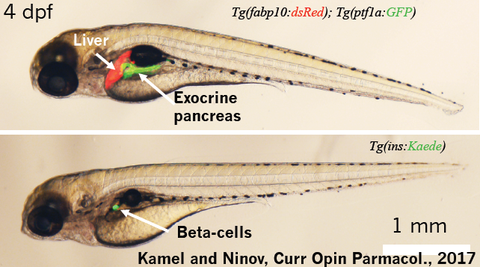Nov 26, 2019
Zebrafish are a key to successfully treating diabetes
Recently, IRTG PhD-student Margrit Kamel talked to the MDR about her research on Diabetes and the importance of zebrafish. She also shared the relevance of and progress in her project with us:
“First, let me tell you a little bit about the life of a zebrafish.
It takes three months for a zebrafish to become a mature adult. One adult female can lay up to 300 eggs at a time and you can build facilities to house thousands of these zebrafish, happily swimming in their tanks. Additionally, they develop very quickly. Like us, the zebrafish starts out as a single cell, but the growth that takes us months, they can do in a couple of days. Within five days, they already have a pancreas, liver, gut, brain, eyes, heart and start swimming around, hunting for food. These zebrafish larvae are mostly transparent and you can see their organs right through their skin.
Many of the genes that zebrafish and humans have in common play a very important role in development and in disease.
For example, pdx1 is a gene that is responsible for the development of the pancreas. Humans that carry a mutation in this gene either have a dysfunctional pancreas that can result in them developing diabetes or, in severe cases, are missing most of their pancreas.
We can mimic this disease in zebrafish by disrupting the same gene in the larvae. Using a microscope, we can watch as the organ develops and study how it functions in response to the demands of a growing larvae. The next step is to test out different drugs on the zebrafish and identify which ones help improve the function of the organ or switch on genes that help the fish recover after damage.
However, zebrafish can also be used to understand basic biology, or how cells behave in their native environment.
Our lab recently published a paper in nature metabolism where we show how beta-cells have a system where they work together to sense and respond to changes in glucose levels in the blood. After you eat a meal, the glucose levels in your blood increase. Beta-cells in your pancreas then sense the spike in glucose and respond by releasing insulin directly into the blood stream, which lowers the glucose level. When the glucose level goes back to normal, they stop.
Our recent work shows that, much like a company with a CEO, the beta-cells work as a team under the coordination of a “leader-cell”. Leader cells have a controlling role; it is possible that they are better at sensing an increase in glucose and, like a good CEO, get the beta-cells to work together to satisfy the demand for insulin.
In diabetes, the beta-cells are destroyed or they become dysfunctional due to a genetic or environmental cause. With time, they stop responding to increased glucose levels and the patient with diabetes has to inject insulin in order to survive.
It is possible that these leader cells play a very important role in the development of the disease and by understanding how they work, we might be able to come up with ways to help the body fight diabetes. The zebrafish was a key part in validating the presence, and role, of leader cells.”
The full article about zebrafish and their role in research can be found at https://www.jumpradio.de/thema/zebrafische-herzzellen-nachwachsen-100_zc-97379c5c_zs-1c093e41.html (in German only).

